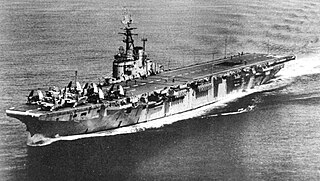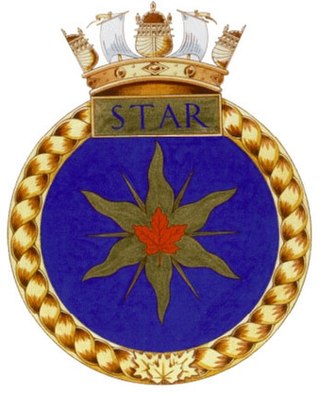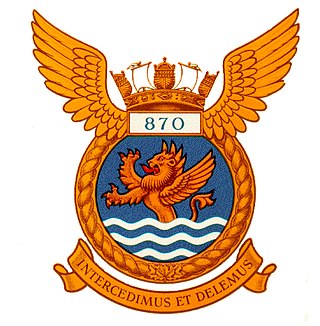
The Canadian Armed Forces are the unified military forces of Canada, including land, sea, and air commands referred to as the Canadian Army, Royal Canadian Navy and the Royal Canadian Air Force. The CAF also operates several other commands, including the Canadian Forces Intelligence Command, the Canadian Joint Operations Command, and the Canadian Special Operations Forces Command. Personnel may belong to either the Regular Force or the Reserve Force, which has four sub-components: the Primary Reserve, Supplementary Reserve, Cadet Organizations Administration and Training Service, and the Canadian Rangers. Under the National Defence Act, the Canadian Armed Forces are an entity separate and distinct from the Department of National Defence, which also exists as the civilian support system for the forces.

The Royal Canadian Navy is the naval force of Canada. The navy is one of three environmental commands within the Canadian Armed Forces. As of February 2024, the RCN operates 12 Halifax-class frigates, 12 Kingston-class coastal defence vessels, 4 Victoria-class submarines, 4 Harry DeWolf-class offshore patrol vessels, 8 Orca-class patrol vessels, and several auxiliary vessels. The RCN consists of 8,400 Regular Force and 4,100 Primary Reserve sailors, supported by 3,800 civilians. Vice-Admiral Angus Topshee is the commander of the Royal Canadian Navy and chief of the Naval Staff.
The history of the Royal Canadian Navy goes back to 1910, when the naval force was created as the Naval Service of Canada and renamed a year later by King George V. The Royal Canadian Navy (RCN) is one of the three environmental commands of the Canadian Forces. Over the course of its history, the RCN has played a role in the First World War, contributed significantly to the Battle of the Atlantic during the Second World War, and was a part of NATO's force buildup during the Cold War. In 1968, the RCN was amalgamated with the Canadian Army and the Royal Canadian Air Force to form what is today the unified Canadian Armed Forces. The naval force was known as Maritime Command until 2011, when the environmental command was renamed as the Royal Canadian Navy.

HMCS Magnificent was a Majestic-class light aircraft carrier that served the Royal Canadian Navy from 1948–1957. Initially ordered by the Royal Navy during World War II, the Royal Canadian Navy acquired the Magnificent while waiting for another aircraft carrier to be completed to their needs and it entered service in 1948 replacing in service HMCS Warrior which had been loaned for two years by the RN.

The designation His Majesty's Canadian Ship, is applied as a prefix to surface ships in the Royal Canadian Navy and Canadian Joint Operations Command. The similar designation of His Majesty's Canadian Submarine is applied to submarine vessels.

Shearwater Heliport, formerly known as Canadian Forces Base Shearwater and commonly referred to as CFB Shearwater and formerly named HMCS Shearwater, is a Canadian Forces facility located 4.5 nautical miles east southeast of Shearwater, Nova Scotia, on the eastern shore of Halifax Harbour in the Halifax Regional Municipality. Following a base rationalization program in the mid-1990s, the Canadian Forces closed CFB Shearwater as a separate Canadian Forces base and realigned the property's various facilities into CFB Halifax.

Canadian Forces Base (CFB) Halifax is Canada's east coast naval base and home port to the Royal Canadian Navy Atlantic fleet, known as Canadian Fleet Atlantic (CANFLTLANT), that forms part of the formation Maritime Forces Atlantic (MARLANT).

The Navy League of Canada is a nonprofit organization founded in 1895 and incorporated in 1918. Originally formed to promote maritime issues to Canadians, the Navy League is the non-governmental partner of the Department of National Defence and supports the Royal Canadian Sea Cadets program. The Navy League also independently delivers the Navy League Cadet program for boys and girls between the ages of nine and twelve.
Before Unification as the Canadian Armed Forces in 1968, the Canadian military had three distinct services: the Royal Canadian Navy, the Royal Canadian Air Force, and the Canadian Army. All three services had a Regular (full-time) component and a reserve (part-time) component. The rank structure for these services were based on the services of the British military, the Royal Navy, the Royal Air Force, and the British Army. The change to a "Canadian" rank structure meant that many of the traditional (British) rank titles and insignia were removed or changed.

Admiral Percy Walker Nelles, was a flag officer in the Royal Canadian Navy (RCN) and the Chief of the Naval Staff from 1 January 1934 to 15 January 1944. He oversaw the massive wartime expansion of the RCN and the transformation of Canada into a major player in the Battle of the Atlantic. During his tenure U-boats raided the Gulf of St. Lawrence, Canadian Northwest Atlantic command was created, and the RCN provided up to 40% of all escort forces in the North Atlantic. His handling of the RCN's war effort had its opponents however, and he was removed from his post as Chief of the Naval Staff in January 1944. He was sent to London as Overseas Naval Attaché, coordinating RCN operations for Operation Overlord. He retired in January 1945 as a full admiral.

HMCS Charlottetown was a River-class frigate that served with the Royal Canadian Navy (RCN) during the Second World War. She was the second vessel of the name, HMCS Charlottetown having been a Flower-class corvette that had been sunk earlier in the war. They are unique for being the only two ships to have shared the same pennant number, K 244. She was named for Charlottetown, Prince Edward Island.

HMCS Star is a Canadian Forces Naval Reserve Division (NRD) located in Hamilton, Ontario. Dubbed a stone frigate, HMCS Star is a land-based naval establishment for training part-time sailors as well as functioning as a local recruitment centre for the Royal Canadian Navy (RCN). The second oldest of 24 naval reserve divisions located in major cities across Canada, Star was stood up on 15 March 1923 as the Royal Canadian Naval Volunteer Reserve (RCNVR) Hamilton Half Company and then on 1 November 1941 as HMCS Star.

The Naval Reserve is the Primary Reserve component of the Royal Canadian Navy (RCN). The primary mission of the NAVRES is to force generate sailors and teams for Canadian Armed Forces (CAF) operations, including: domestic safety operations as well as security and defence missions, while at the same time supporting the Navy's efforts in connecting with Canadians through the maintenance of a broad national presence.

The Canadian Naval Ensign is the flag worn at the stern or at the gaff of His Majesty's Canadian Ships. The ensign is also the flag of the Royal Canadian Navy (RCN) and is used on land in this capacity.
At the onset of Confederation in 1867, political planners in Canada and Great Britain realized that Canada had substantial maritime interests to protect. Boasting the fourth largest Merchant Marine in the world, and deriving the majority of its foreign capital through maritime trading should have been enough to persuade the Canadian government of the strategic importance of the seas. Adding the fact that Canada was one of the great shipbuilding and ship-owning countries of the world, and it soon made the need for maritime protection obvious.
HMCS Cataraqui is a Canadian Forces Naval Reserve Division (NRD) located in Kingston, Ontario. Dubbed a stone frigate, HMCS Cataraqui is a land-based naval establishment for part-time sailors as well as a local recruitment centre for the Royal Canadian Navy (RCN). It is one of 24 naval reserve divisions located in major cities across Canada.

870 Naval Air Squadron, also known as VF-870, was a squadron of the Royal Canadian Navy (RCN). It was formed when 803 Naval Air Squadron of the Royal Navy was renumbered to 870 NAS on 1 May 1951. It operated throughout the 1950s and early 1960s before disbanding on 7 September 1962. It was the first RCN squadron to operate jet aircraft.
HMCS Queen Charlotte is a Canadian Forces Naval Reserve Division (NRD) located in Charlottetown, Prince Edward Island. Dubbed a stone frigate, HMCS Queen Charlotte is a land-based naval training establishment crewed by part-time sailors and also serves as a local recruitment centre for the Royal Canadian Navy (RCN). It is one of 24 naval reserve divisions located in major cities across Canada.

Navy bands in Canada are part of the Royal Canadian Navy's command structure and overseen by the Music Branch of the Canadian Forces and the Directorate of History and Heritage of the Department of National Defence.













